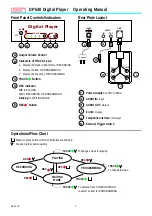
H-2
Cisco Interactive Services Solution Content Creation Guidelines
Appendix H Content Guidelines
Content Guidelines
Video Performance
Limitations
When using a native player, the IEC 4610 can support H.264 video up to
720p @ 6Mbps.
Note
The amount of CPU power required to decode a video clip
depends on multiple factors such as codec, bitrate, and
resolution of the video source.
Different video codecs have different compression algorithms. H.264
offers much better compression efficiency than MPEG-2 or MPEG-4 but
uses much more a complex algorithm and requires more CPU power to
decode. For example, to achieve the same level of quality, it may require
5 Mbps using MPEG2 but less than 2 Mbps using H.264.
The IEC 4610 can decode 1080p 14Mbps MPEG2 video with less than
90% of CPU usage, but cannot decode 720p 8Mbps H.264 video without
obvious frame drops.
Note
When the video source is interlaced (1080i, 480i, etc.), you may
see interlacing artifacts due to the lack of de-interlacing
capability on the native player.
Note
The size of the native player object does not affect the CPU
usage. If the video source is the same, the CPU usage is the same
regardless of the player's height and width. That is, if the video
source is 1280x720, the CPU usage will not change by setting
the native player's size to 320x180 or 1920x1080.
Screen Resolutions
Up to 1920x1080 (1080p); IEC4600 Series defaults to monitor’s native
resolution
To ensure the content scales well, build for the lowest resolution
expected, then use stretchers to make sure it can stretch to the highest
resolution expected.
Screen Rotations
Both horizontal (landscape) and vertical (portrait) modes are supported
with 90, 180, 270 degree turns. The content should be laid out naturally.
General Content Guidelines
HTML/JavaScript is a preferred mechanism for building kiosk
applications.
Use of Flash should be limited to small size and non-video rendering
functionality.
Ticker tapes should be using CSS3 for scrolling.
“Screensaver” video playback should be postponed when the kiosk is
being interacted with to avoid audio conflicts and preserve
responsiveness.
Regularly-playing videos should be cached locally.





































